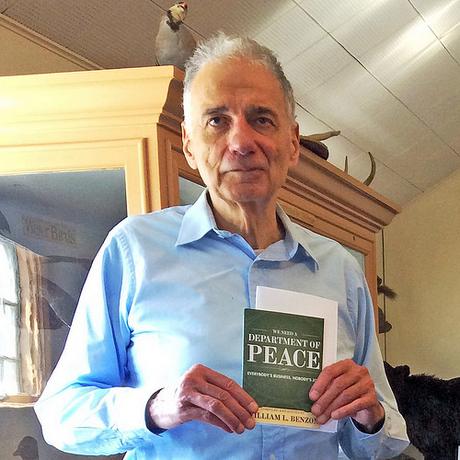GVMBP 2018

Sunday I posted some photos from Saturday’s Massive Block Party, thrown by Green Villain, Writer’s Workbench, and VYV Apartments. More on went up on Tuesday.
Onward Ho!
On Sunday I uploaded another essay to 3 Quarks Daily: Three Children Of The Space Age: Elon Musk, Freeman Dyson, And Me. That essay, of course, goes deep into my past, up through the present and, who knows, maybe into the future. But I wrote it as kind of an outer out-there bounds to a project I’ve been working on with Charlie Keil, a series of little books, or pamphlets, on the theme: Local Paths to Peace Today. We published the first volume two years ago: We Need a Department of Peace: Everybody's Business, Nobody's Job.

Ralph Nader with his copy of We Need a Department of Peace
We’ve just sent the second volume off to press: Thomas Naylor’s Paths to Peace: Small is Necessary. That’s about how everything’s too damn big, especially the states we live in. We’re now working on a third volume which doesn’t have a title yet (though CK likely has something he’s thinking about). For the moment let’s call it Where We Want to Go: Cooperation and the Common Glad Impulse.Well, I figure we need to present some scenario for a different future, the opposite of those dystopian scenarios I wrote for Abbe Mowshowitz two decades ago. Now, you see, CK is something of a Luddite and has no interest in manned space travel, but I’m a bit different. Elon Musk has interesting things to say about where we’re going and how we get there, so I figured that would be a good warm-up.
Moving closer to Where We Want to Go, I’m participating in a group reading of Kim Stanley Robinson’s New York 2140, which is about a future in which the seas have risen 50 feet. Can we live in that world? Robinson says we can. I think so too. My idea is to take KSR’s world and tweak it a bit to meet our requirements, Charlie’s and mine. Of course, I’ve already read and blogged about New York 2140, but Bryan Alexander, futurist and educational consultant, has just kicked off a group reading. I figure that’s a good way for me to see what others think about the future.
This kicked off a series of posts on Musk, the simulation argument, and the Singularity. I’ll likely return here from time to time.
Joe Rogan’s reality club
On Thursday I returned to my interest in Joe Rogan with a long post, Joe Rogan and Joey Diaz call “Bruce Lee vs. Chuck Norris” – a rough transcription of their conversation. The title tells the story. I took a ten minute conversation that Rogan had with his buddy, Joe Diaz, about a scene from a classic martial arts film. Why’d I do that? Because I’m interested in what Rogan does and how he does it. Conversation’s his medium. The next step is to go through the conversation and comment on it, like I did with a paragraph from Heart of Darkness.
I don’t know when I’ll get around to this. Or even if I will. But I really should, shouldn’t I? And then I can wrap up my Rogan posts into another working paper.
Computational Lit Crit
Later on Thursday I published a long post on Michael Gavin’s recent article, Vector Semantics, William Empson, and the Study of Ambiguity. This first post centered on a famous memorandum, Gavin 1.1: Warren Weaver (1949) and statistical semantics. I’ve got two more posts planned for this series:
- Gavin 1.2: Warren Weaver 1949 and compositional semantics
- Gavin 2: Comments on a passage from “Paradise Lost”
The idea is to compare and contrast three distinct approaches to meaning, traditional “close-reading”, statistical semantics (which is well known in the digital humanities), and what I’m calling compositional or constructive semantics, which is not so well-known. Compositional semantics is what I did my doctoral work on. It’s well developed in cognitive science, but also in computational narratology, and computer gaming. Once I’ve got all three on the table (in Gavin 2) I can make a distinction between close reading on the one hand, and statistical and compositional semantics on the other. Close reading is about meaning, and meaning is ontologically subjective (in Searle’s sense). But statistical and compositional semantics are not. The exist in the object realm; they objectify meaning. Close reading is validated through ethical arguments; it is a tool of ethical criticism.
Statistical and compositional semantics are somewhat different and I’ve not yet figured out just how to talk about them. For the moment, let’s say that statistical semantics are assessed with respect to truth. Within cognitive criticism statistical semantics may be used in the context of an argument that is basically about meaning.
Compositional semantics as well can be assessed as to its truth. But it also has engineering uses.
It’s complicated.
* * * * *
And I’ve got to keep all these balls in the air, Green Villain, scenarios for the future, Rogan, and cognitive criticism.
And the photographs. Took several hundred this week.
That’s a lot of work.

